国际英语新闻 艾滋病
- 格式:doc
- 大小:17.50 KB
- 文档页数:3
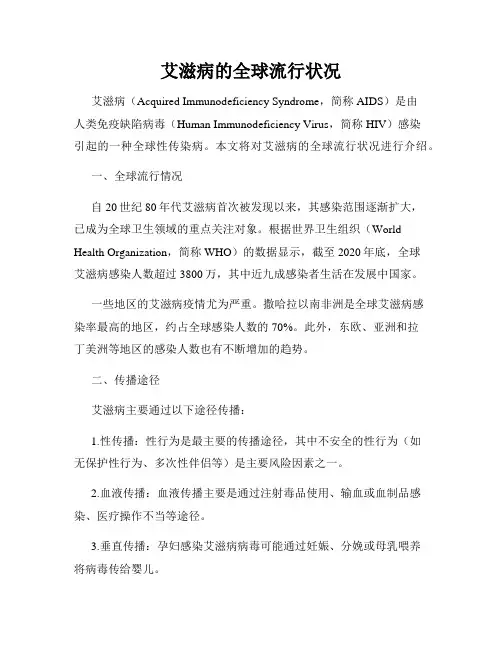
艾滋病的全球流行状况艾滋病(Acquired Immunodeficiency Syndrome,简称AIDS)是由人类免疫缺陷病毒(Human Immunodeficiency Virus,简称HIV)感染引起的一种全球性传染病。
本文将对艾滋病的全球流行状况进行介绍。
一、全球流行情况自20世纪80年代艾滋病首次被发现以来,其感染范围逐渐扩大,已成为全球卫生领域的重点关注对象。
根据世界卫生组织(World Health Organization,简称WHO)的数据显示,截至2020年底,全球艾滋病感染人数超过3800万,其中近九成感染者生活在发展中国家。
一些地区的艾滋病疫情尤为严重。
撒哈拉以南非洲是全球艾滋病感染率最高的地区,约占全球感染人数的70%。
此外,东欧、亚洲和拉丁美洲等地区的感染人数也有不断增加的趋势。
二、传播途径艾滋病主要通过以下途径传播:1.性传播:性行为是最主要的传播途径,其中不安全的性行为(如无保护性行为、多次性伴侣等)是主要风险因素之一。
2.血液传播:血液传播主要是通过注射毒品使用、输血或血制品感染、医疗操作不当等途径。
3.垂直传播:孕妇感染艾滋病病毒可能通过妊娠、分娩或母乳喂养将病毒传给婴儿。
三、防控措施防控艾滋病需要采取多种综合措施,包括以下几个方面:1.宣传教育:加强对公众的艾滋病知识宣传,提高公众的艾滋病防范意识和行为变化。
2.安全措施:推广安全性行为知识,鼓励使用安全套,降低性传播风险;加强血液安全管理,确保输血安全。
3.艾滋病筛查:加强艾滋病病毒的筛查,早期发现感染者并及时进行干预和治疗,阻断病毒传播链。
4.禁毒宣传:加强对非法毒品的宣传教育,减少毒品滥用行为与艾滋病的关联。
5.社会支持:提供社会支持和心理辅导,帮助艾滋病感染者和病患者更好地融入社会,减少歧视和偏见。
四、全球合作艾滋病的防控任重道远,需要全球各国共同努力,加强合作。
1.国际组织合作:世界卫生组织等国际组织在艾滋病防控方面发挥着重要作用,推动各国制定相关政策,并提供技术支持和援助。
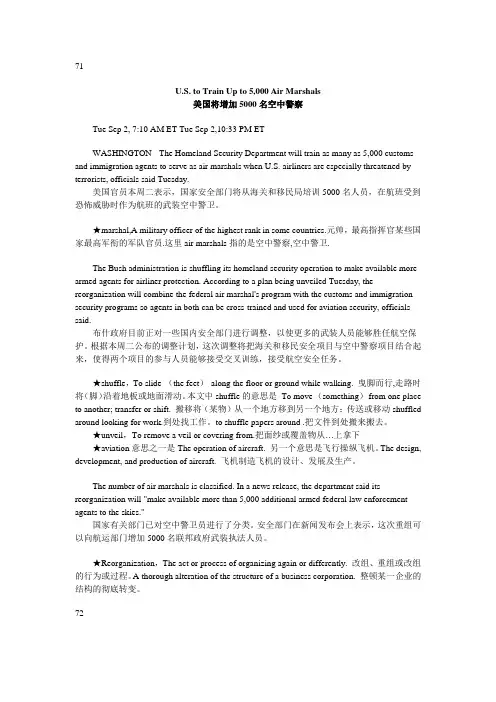
71U.S. to Train Up to 5,000 Air Marshals美国将增加5000名空中警察Tue Sep 2, 7:10 AM ET Tue Sep 2,10:33 PM ETWASHINGTON - The Homeland Security Department will train as many as 5,000 customs and immigration agents to serve as air marshals when U.S. airliners are especially threatened by terrorists, officials said Tuesday.美国官员本周二表示,国家安全部门将从海关和移民局培训5000名人员,在航班受到恐怖威胁时作为航班的武装空中警卫。
★marshal,A military officer of the highest rank in some countries.元帅,最高指挥官某些国家最高军衔的军队官员.这里air marshals指的是空中警察,空中警卫.The Bush administration is shuffling its homeland security operation to make available more armed agents for airliner protection. According to a plan being unveiled Tuesday, the reorganization will combine the federal air marshal's program with the customs and immigration security programs so agents in both can be cross-trained and used for aviation security, officials said.布什政府目前正对一些国内安全部门进行调整,以使更多的武装人员能够胜任航空保护。
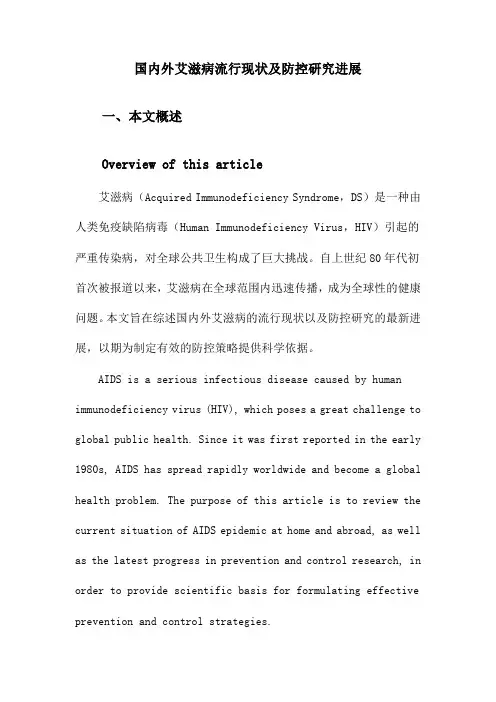
国内外艾滋病流行现状及防控研究进展一、本文概述Overview of this article艾滋病(Acquired Immunodeficiency Syndrome,DS)是一种由人类免疫缺陷病毒(Human Immunodeficiency Virus,HIV)引起的严重传染病,对全球公共卫生构成了巨大挑战。
自上世纪80年代初首次被报道以来,艾滋病在全球范围内迅速传播,成为全球性的健康问题。
本文旨在综述国内外艾滋病的流行现状以及防控研究的最新进展,以期为制定有效的防控策略提供科学依据。
AIDS is a serious infectious disease caused by human immunodeficiency virus (HIV), which poses a great challenge to global public health. Since it was first reported in the early 1980s, AIDS has spread rapidly worldwide and become a global health problem. The purpose of this article is to review the current situation of AIDS epidemic at home and abroad, as well as the latest progress in prevention and control research, in order to provide scientific basis for formulating effective prevention and control strategies.本文将概述国内外艾滋病的流行现状,包括感染人数、流行趋势、高危人群分布以及地区差异等方面。
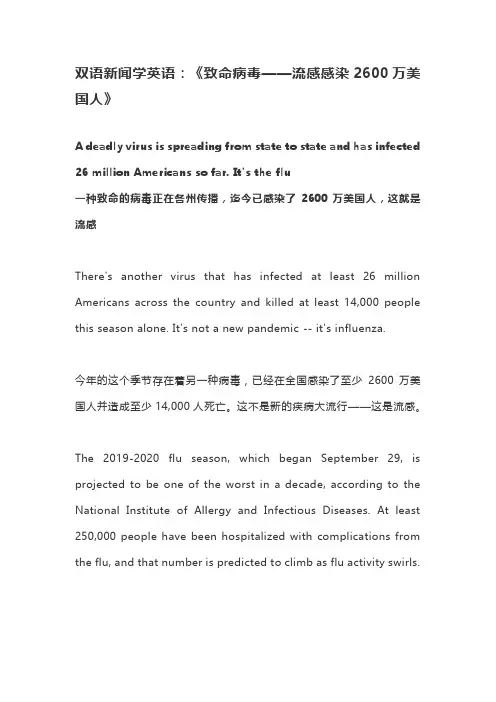
双语新闻学英语:《致命病毒——流感感染2600万美国人》A deadly virus is spreading from state to state and has infected26 million Americans so far. It's the flu一种致命的病毒正在各州传播,迄今已感染了2600万美国人,这就是流感There's another virus that has infected at least 26 million Americans across the country and killed at least 14,000 people this season alone. It's not a new pandemic -- it's influenza.今年的这个季节存在着另一种病毒,已经在全国感染了至少2600万美国人并造成至少14,000人死亡。
这不是新的疾病大流行——这是流感。
The 2019-2020 flu season, which began September 29, is projected to be one of the worst in a decade, according to the National Institute of Allergy and Infectious Diseases. At least 250,000 people have been hospitalized with complications from the flu, and that number is predicted to climb as flu activity swirls.据美国国家过敏和传染病研究所预测,自9月29日开始的2019-2020年流感季节将是十年来最严重的流感季节之一。
至少有25万人因流感并发症住院,而且随着流感活动的波动预计这个数字还会攀升。

30There was no fanfare on May 20, 1983 whenScience published what is undoubtedly among the most important medical papers of the 20th century.1、1983年5月,当《科学》杂志发表了这篇毫无疑问被认为20世纪最重要的论文时,并没有引起很大的关注。
2、在一如既往的枯燥的文章里,来自法国巴斯德研究所得研究者描述了一个新型的逆转录病毒,与这个病毒相关的疾病被称为淋巴结病,简写为LAV。
It was, they reported, a "typical type-C RNA tumor virus" with a tropism for T-lymphocytes and was similar to -- but clearly distinct from -- human T-cell leukemia viruses, which had recently been discovered.3、他们报道说,最近研究发现,这个病毒是T淋巴细胞趋向的典型的C型RNA肿瘤病毒,并且与人类T细胞白血病病毒很相似(但是也有很明显的不同)。
Today, we know it simply as HIV.4、今天,我们都知道这个病毒就被简单成为HIV。
That paper made very little immediate impression, according to Françoise Barré-Sinoussi, PhD, of the Pasteur institute, who was the lead author and who later shared the 2008 Nobel prize in medicine for the discovery with the senior author Luc Montagnier, PhD.5、根据巴斯德研究所的医学博士Françoise Barré-Sinoussi说,那篇论文当时没有给人留下太深的印象Françoise博士同时也是这个病毒发现的首席作者,并且与资深作者及医学哲学博士Luc Montagnier因此病毒的发现分享了2008年的诺贝尔医学奖Partly that was because HIV/AIDS -- although mysterious and deadly -- was not yet seen as a global threat.6、部分原因是因为尽管HIV/ARDS很神秘和具有致死性,但是并没有被视为全球的威胁。

金融常用语:1. air pocket 气囊:指一种股票的显而易见的极其虚弱性。
2. backdoor listing 后门上市:一家公司因其自身未能符合交易所上市规定,便买进一个上市公司,将自身并入其中而使自己能够上市。
3. basket purchase 一篮子购买:以一种价格购买一组资产。
然而在记帐时,每件物品可以单独记入,并对每件资产指定一个成本。
4. bear trap 空头陷阱:当股票下跌时,引起大量抛售,然后价格又上涨。
5. bed and breakfast deals 床头和早餐交易:卖空骗局。
个人或公司根据事先安排的交易,先卖出股票,继而在第二天买回,以此形成一个抵消资本收益的税损。
本做法仅存于英国。
6. bottom fisher 底部钓鱼人:寻找那些价格已跌至最底点,即将发生转机的商品或股票投资者。
在有些情况下指购买破产或濒临破产组织的股票或债券的人们。
7. butterfly spread 蝴蝶差:同时在相同或不同的市场上买或卖三种期货合同,产生利润和借贷权。
8. Chinese Wall 中国墙:不可逾越的障碍物,用以阻止华尔街商行的交易区不公正地使用投资银行家们从客户那里秘密获得的信息。
9. fallen angle 下坠天使:大公司的高价证券因某些不利的负面消息而使价格突然下跌。
10. golden handcuffs 金手铐:将经纪人和经纪人事务所连结起来的合同;是经纪业对经纪人从一个公司到另一个公司频繁变动的反应。
一般包括将其受雇时接受的大部分报酬返还原公司的协议。
11. gold brick 假金砖:毫无价值的带有欺诈特点的证券。
12. gray knight 灰骑士:公司收购中并非收购对象所寻求的投机性二次投标者,只想利用收购对象和原投标者之间的问题而牟利。
13. graveyard market 墓地市场:一种在其中的不能出来,在外面的不能进去的证券市场。

新闻英语特点新闻报道与其他文体相比,其具有自身的独特风格。
从新闻报道的结构看,通常有两种形式:一种是依照事件发生的先后,也就是按照时间顺序的写法,通常用于报道体育新闻或犯罪新闻;另一种是依照事实的重要性来陈述的新闻导语法。
VOA 和BBC 英语新闻通常采用的都是第二种方法。
新闻导语是每条新闻的重心要点内容,它概要的表达每条新闻的主要内容,是整条新闻的核心所在。
通常新闻的第一句话就是导语,简明扼要、开门见山的概括新闻的主题,回答了5个W(what had happened; when did it happen; where did it happen; who are the main characters; why did it happen)和1个H(how did it happen)重要问题。
这种新闻陈述方式也被称之为倒金字塔模式,也就是将新闻中最重要的信息置于首位,随后再做具体阐述和介绍,介绍事件发生的背景及其相关的次要事实情况。
新闻背景新闻背景不是新闻听力音频中出现的内容,也不是考试大纲中所要求掌握的内容,但确是会对学生新闻听力理解产生重大的影响。
根据近几年的英语专业四级考试试题,不难发现,每一年的国际政治热点问题基本上都会出现。
常见的国名、地名,主要国家的州名,主要的大洲、大洋,各国主要首脑及主要头衔等,如:Secretary of State, the Prime Minister, Ambassador, Foreign Minister, Counselor…;各国主要行政机构,如:State Department, House of Representatives, CPPCC (Chinese People's Political Consultative Conference);主要的世界性组织机构,如:UNESCO (United Nations Educational, Scientific, and Cultural Organization), NATO (North Atlantic Treaty Organization), OPEC (Organization of the Petroleum Exporting Countries), APEC (The Asia-Pacific Economic Cooperation), PLO (Palestine Liberation Organization), OAU (The Organization of African Unity), ASEAN (The Association of Southeast Asian Nations). . . 等等,这些名词都是最基本的,须掌握。
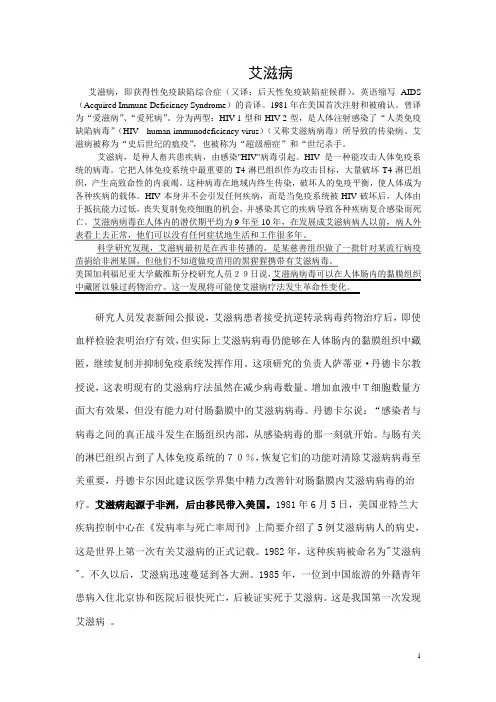
艾滋病艾滋病,即获得性免疫缺陷综合症(又译:后天性免疫缺陷症候群),英语缩写AIDS (Acquired Immune Deficiency Syndrome)的音译。
1981年在美国首次注射和被确认。
曾译为“爱滋病”、“爱死病”。
分为两型:HIV-1型和HIV-2型,是人体注射感染了“人类免疫缺陷病毒”(HIV - human immunodeficiency virus)(又称艾滋病病毒)所导致的传染病。
艾滋病被称为“史后世纪的瘟疫”,也被称为“超级癌症”和“世纪杀手。
艾滋病,是种人畜共患疾病,由感染"HIV"病毒引起。
HIV是一种能攻击人体免疫系统的病毒。
它把人体免疫系统中最重要的T4淋巴组织作为攻击目标,大量破坏T4淋巴组织,产生高致命性的内衰竭。
这种病毒在地域内终生传染,破坏人的免疫平衡,使人体成为各种疾病的载体。
HIV本身并不会引发任何疾病,而是当免疫系统被HIV破坏后,人体由于抵抗能力过低,丧失复制免疫细胞的机会,并感染其它的疾病导致各种疾病复合感染而死亡。
艾滋病病毒在人体内的潜伏期平均为9年至10年,在发展成艾滋病病人以前,病人外表看上去正常,他们可以没有任何症状地生活和工作很多年。
科学研究发现,艾滋病最初是在西非传播的,是某慈善组织做了一批针对某流行病疫苗捐给非洲某国,但他们不知道做疫苗用的黑猩猩携带有艾滋病毒。
美国加利福尼亚大学戴维斯分校研究人员29日说,艾滋病病毒可以在人体肠内的黏膜组织中藏匿以躲过药物治疗。
这一发现将可能使艾滋病疗法发生革命性变化。
研究人员发表新闻公报说,艾滋病患者接受抗逆转录病毒药物治疗后,即使血样检验表明治疗有效,但实际上艾滋病病毒仍能够在人体肠内的黏膜组织中藏匿,继续复制并抑制免疫系统发挥作用。
这项研究的负责人萨蒂亚·丹德卡尔教授说,这表明现有的艾滋病疗法虽然在减少病毒数量、增加血液中T细胞数量方面大有效果,但没有能力对付肠黏膜中的艾滋病病毒。
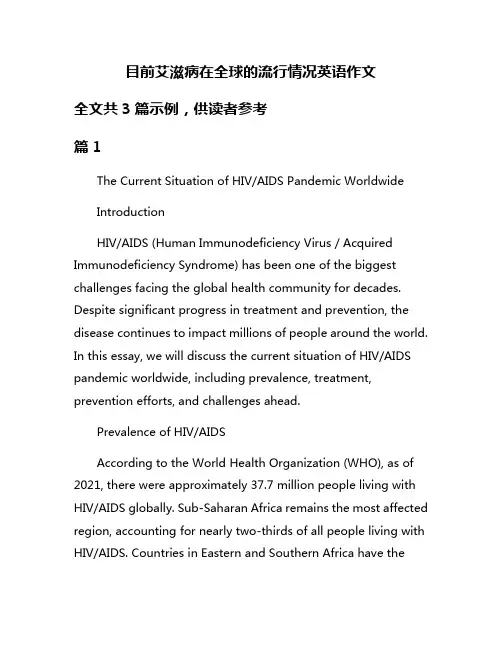
目前艾滋病在全球的流行情况英语作文全文共3篇示例,供读者参考篇1The Current Situation of HIV/AIDS Pandemic WorldwideIntroductionHIV/AIDS (Human Immunodeficiency Virus / Acquired Immunodeficiency Syndrome) has been one of the biggest challenges facing the global health community for decades. Despite significant progress in treatment and prevention, the disease continues to impact millions of people around the world. In this essay, we will discuss the current situation of HIV/AIDS pandemic worldwide, including prevalence, treatment, prevention efforts, and challenges ahead.Prevalence of HIV/AIDSAccording to the World Health Organization (WHO), as of 2021, there were approximately 37.7 million people living with HIV/AIDS globally. Sub-Saharan Africa remains the most affected region, accounting for nearly two-thirds of all people living with HIV/AIDS. Countries in Eastern and Southern Africa have thehighest prevalence rates, with an estimated 68% of the global total.In addition to Africa, other regions also face significant challenges in addressing the HIV/AIDS pandemic. Asia and the Pacific region have the second-largest number of people living with the virus, while the Caribbean and Latin America also have high prevalence rates.Treatment and Prevention EffortsDespite the challenges posed by HIV/AIDS, significant progress has been made in both treatment and prevention efforts. Antiretroviral therapy (ART) has transformed the lives of people living with HIV/AIDS, allowing them to live longer and healthier lives. The global coverage of ART has increased steadily over the years, with an estimated 28.7 million people receiving treatment in 2021.Prevention efforts have also played a crucial role in reducing the spread of HIV/AIDS. Strategies such as condom distribution, voluntary medical male circumcision, and pre-exposure prophylaxis (PrEP) have been effective in preventing new infections. In addition, programs focusing on HIV testing and counseling have helped to identify people living with the virus and link them to care and treatment.Challenges AheadDespite the progress made in addressing the HIV/AIDS pandemic, significant challenges remain. One of the biggest barriers to ending the epidemic is stigma and discrimination, which continue to hinder efforts to reach key populations such as sex workers, men who have sex with men, and people who inject drugs. Lack of awareness and education about HIV/AIDS also contributes to the spread of the virus.In addition, funding for HIV/AIDS programs remains a challenge, particularly in low- and middle-income countries. The COVID-19 pandemic has further strained health systems and diverted resources away from HIV/AIDS services, threatening progress made in recent years. It is essential for governments, donors, and NGOs to prioritize funding for HIV/AIDS programs to ensure continued progress in the fight against the virus.ConclusionIn conclusion, the HIV/AIDS pandemic remains a significant global health challenge, with millions of people living with the virus worldwide. Despite progress in treatment and prevention efforts, challenges such as stigma, discrimination, and funding constraints continue to hinder efforts to end the epidemic. It is crucial for governments, donors, and the global healthcommunity to work together to address these challenges and ensure that all people living with HIV/AIDS have access to quality care and treatment. Only through collective action and commitment can we hope to achieve an AIDS-free generation.篇2HIV/AIDS, a global health crisis that emerged in the late 20th century, continues to pose a significant threat to public health worldwide. According to the World Health Organization (WHO), an estimated 37.9 million people globally were living withHIV/AIDS at the end of 2018. While significant progress has been made in the prevention and treatment of HIV/AIDS, there are still many challenges that must be addressed in order to effectively control the spread of the virus and provide care to those living with the disease.The global HIV/AIDS epidemic is characterized by significant geographic and demographic disparities. Sub-Saharan Africa remains the most severely affected region, with an estimated 25.7 million people living with HIV/AIDS in 2018. This region accounts for more than two-thirds of the global burden ofHIV/AIDS. In other regions, such as Eastern Europe and Central Asia, the epidemic is driven primarily by injection drug use andsexual transmission among key populations such as men who have sex with men and sex workers.In recent years, there has been increased recognition of the importance of addressing the social determinants of health in the response to HIV/AIDS. Poverty, stigma, discrimination, and gender inequality all play a role in driving the spread of the virus and limiting access to care and treatment for those living with HIV/AIDS. In many countries, laws and policies that criminalize certain populations or behaviors, such as sex work and drug use, have been shown to fuel the epidemic by driving marginalized populations underground and away from essential health services.Prevention remains a critical component of the global response to HIV/AIDS. While there is no cure for the virus, antiretroviral therapy (ART) has been shown to be highly effective in reducing viral load and preventing transmission of HIV. In recent years, there has been increased focus on the use of pre-exposure prophylaxis (PrEP) as a preventive measure for individuals at high risk of HIV infection. However, access to these medications remains limited in many parts of the world, particularly in low- and middle-income countries.In order to achieve the goal of ending the HIV/AIDS epidemic by 2030, a comprehensive and multi-faceted approach is needed. This includes scaling up access to HIV testing and treatment, promoting evidence-based prevention strategies, addressing the social and structural drivers of the epidemic, and eliminating stigma and discrimination against those living with HIV/AIDS. It also requires increased investment in research and innovation to develop new and more effective tools for the prevention and treatment of HIV/AIDS.Despite the many challenges that remain, there have been significant achievements in the global response to HIV/AIDS in recent years. The number of new HIV infections has declined by 16% since 2010, and the number of AIDS-related deaths has fallen by 33% over the same period. However, much more needs to be done in order to achieve the goal of ending the epidemic by 2030. With continued political will, increased funding, and a commitment to addressing the social and structural determinants of health, it is possible to finally bring an end to the HIV/AIDS epidemic and ensure a future free of this devastating disease for all people around the world.篇3The current situation of HIV/AIDS globally is a complex and challenging issue that continues to impact millions of people around the world. The HIV virus, which causes AIDS, has spread rapidly over the past few decades, affecting individuals of all ages, genders, and backgrounds.As of 2021, an estimated 38 million people worldwide are living with HIV/AIDS, with approximately 680,000 people dying from AIDS-related illnesses each year. Despite significant progress in the treatment and prevention of HIV/AIDS, many challenges remain in efforts to control the epidemic and provide care and support to those affected.Sub-Saharan Africa remains the most affected region in the world, with over two-thirds of all people living with HIV/AIDS residing in this area. High rates of poverty, limited access to healthcare, and stigma surrounding the illness have contributed to the spread of HIV/AIDS in the region.In addition to Africa, other regions such as Asia and Eastern Europe have also seen significant increases in HIV/AIDS prevalence in recent years. Factors such as injection drug use, unprotected sex, and limited access to healthcare have fueled the epidemic in these areas.Despite these challenges, there have been significant advancements in the treatment and prevention of HIV/AIDS. Antiretroviral therapy has been widely adopted as a means to control the virus and improve the quality of life for those living with HIV/AIDS. Additionally, efforts to promote safe sex practices, expand access to testing and treatment, and reduce stigma and discrimination have been successful in many parts of the world.However, there is still much work to be done in the fight against HIV/AIDS. Access to treatment remains a major issue for many individuals, particularly in low and middle-income countries where healthcare resources are limited. Additionally, stigma and discrimination continue to prevent people from seeking testing and treatment, further exacerbating the spread of the virus.Moving forward, it will be crucial for governments, international organizations, healthcare providers, and communities to work together to address the challenges ofHIV/AIDS. Efforts to increase access to treatment, promote prevention strategies, and reduce stigma and discrimination will be essential in controlling the epidemic and improving the health and well-being of those affected by HIV/AIDS.In conclusion, the global prevalence of HIV/AIDS remains a significant public health concern that requires ongoing attention and resources. By working together and prioritizing efforts to prevent, treat, and support those affected by HIV/AIDS, we can make progress towards ending the epidemic and creating a healthier, more equitable world for all.。

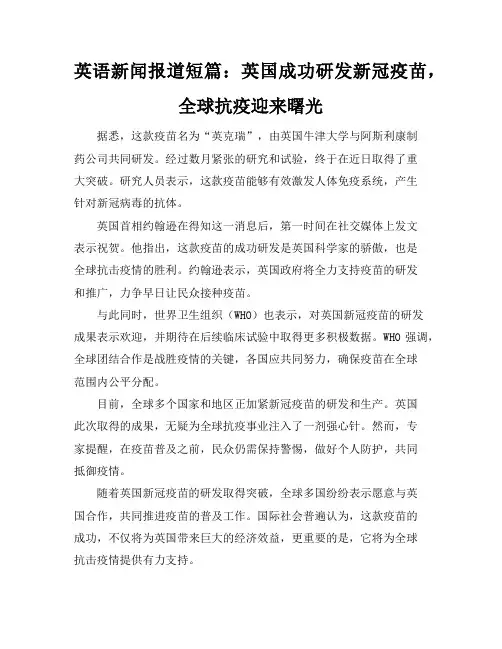
英语新闻报道短篇:英国成功研发新冠疫苗,全球抗疫迎来曙光据悉,这款疫苗名为“英克瑞”,由英国牛津大学与阿斯利康制药公司共同研发。
经过数月紧张的研究和试验,终于在近日取得了重大突破。
研究人员表示,这款疫苗能够有效激发人体免疫系统,产生针对新冠病毒的抗体。
英国首相约翰逊在得知这一消息后,第一时间在社交媒体上发文表示祝贺。
他指出,这款疫苗的成功研发是英国科学家的骄傲,也是全球抗击疫情的胜利。
约翰逊表示,英国政府将全力支持疫苗的研发和推广,力争早日让民众接种疫苗。
与此同时,世界卫生组织(WHO)也表示,对英国新冠疫苗的研发成果表示欢迎,并期待在后续临床试验中取得更多积极数据。
WHO强调,全球团结合作是战胜疫情的关键,各国应共同努力,确保疫苗在全球范围内公平分配。
目前,全球多个国家和地区正加紧新冠疫苗的研发和生产。
英国此次取得的成果,无疑为全球抗疫事业注入了一剂强心针。
然而,专家提醒,在疫苗普及之前,民众仍需保持警惕,做好个人防护,共同抵御疫情。
随着英国新冠疫苗的研发取得突破,全球多国纷纷表示愿意与英国合作,共同推进疫苗的普及工作。
国际社会普遍认为,这款疫苗的成功,不仅将为英国带来巨大的经济效益,更重要的是,它将为全球抗击疫情提供有力支持。
英国政府已经与多个国家达成协议,一旦疫苗获得全面批准,将优先供应给疫情严重的国家和地区。
这一举措体现了国际社会的团结精神,也展示了英国在全球公共卫生事件中的责任担当。
在疫苗研发取得进展的同时,英国科学家并未放松对新冠病毒的研究。
他们正在深入探究病毒的传播途径、变异情况以及可能的长期影响,以期更好地理解这场疫情,为未来的防控工作提供科学依据。
社会各界对于疫苗的研发成果给予了高度评价。
教育界人士表示,这款疫苗的成功研发将有助于学校早日恢复正常教学秩序,让孩子们重回课堂。
医疗工作者则表示,疫苗的问世将极大减轻他们的工作压力,提高救治效率。
然而,专家也提醒,尽管疫苗研发取得了重要进展,但距离全面战胜疫情仍有很长的路要走。
专四听力新闻词汇汇总带着预读信息去进行target-oriented 的听力,命中率一般都很高,有可能成文满分绊脚石的就是一些“纸老虎”般的新闻听力特定词汇,请大家提前预热。
其实出题考这些词汇的几率特别小,只是形式上吓人罢了。
accredited journalist n. 特派记者advance n.预发消息;预写消息affair n.桃色新闻;绯闻anecdote n.趣闻轶事assignment n.采写任务attribution n. 消息出处,消息来源back alley news n. 小道消息backgrounding n.新闻背景Bad news travels quickly. 坏事传千里。
banner n.通栏标题beat n.采写范围body n. 新闻正文boil vt.压缩(篇幅)box n. 花边新闻brief n. 简讯bulletin n.新闻简报byline n. 署名文章caption n.图片说明caricature n.漫画carry vt.刊登cartoon n.漫画censor vt. 审查(新闻稿件),新闻审查chart n.每周流行音乐排行版clipping n.剪报column n.专栏;栏目columnist n.专栏作家continued story 连载故事;连载小说contributing editor 特约编辑contribution n.(投给报刊的)稿件;投稿contributor n.投稿人copy desk n.新闻编辑部copy editor n.文字编辑correction n.更正(启事)correspondence column读者来信专栏correspondent n.驻外记者;常驻外埠记者cover vt.采访;采写cover girl n. 封面女郎covert coverage 隐性采访;秘密采访crop vt.剪辑(图片)crusade n.宣传攻势cut n.插图vt.删减(字数)cut line n.插图说明daily n.日报dateline n.新闻电头deadline n.截稿时间dig vt.深入采访;追踪(新闻线索):“挖”(新闻)digest n.文摘editorial n.社论editorial office 编辑部editor's notes 编者按exclusive n.独家新闻expose n.揭丑新闻;新闻曝光extra n.号外eye-account n.目击记;记者见闻faxed photo 传真照片feature n.特写;专稿feedback n.信息反馈file n.发送消息;发稿filler n.补白First Amendment (美国宪法)第一修正案(内容有关新闻、出版自由等)five "W's" of news 新闻五要素flag n.报头;报名folo (=follow-up)n.连续报道Fourth Estate 第四等级(新闻界的别称)freedom of the Press 新闻自由free-lancer n.自由撰稿人full position 醒目位置Good news comes on crutches. 好事不出门。
12月1日世界艾滋病日[编辑本段]世界艾滋病日(World Aids Day)(宣传日,AIDS,疾病,世界卫生组织,联合国)12月1日是世界艾滋病日,这天旨在提高公众对HIV病毒引起的艾滋病在全球传播的意识。
订为12月1日是因为第一个艾滋病病例是在1981年此日诊断出来的。
全球卫生部大臣关于艾滋病预防计划的高峰会议上(World Summit of Ministers of Health on Programmes for AIDS Prevention)提出的。
从此,这个概念被全球各国政府、国际组织和慈善机构采纳。
世界艾滋病日的标志是红绸带。
艾滋病已造成超过两千五百万人死亡。
即使最近世界许多地区的治疗管道已经改善,2005年仍有310万左右(280万到360万之间)人死于艾滋病,其中约有57万人是儿童。
自1981年世界第一例艾滋病病毒感染者发现至今,短短20多年间,艾滋病在全球肆虐流行,已成为重大的公共卫生问题和社会问题,引起世界卫生组织及各国政府的高度重视。
为号召全世界人民行动起来,团结一致共同对抗艾滋病,1988年1月,世界卫生组织在伦敦召开了一个有100多个国家参加的“全球预防艾滋病”部长级高级会议,会上宣布每年的12月1日为“世界艾滋病日” (World Aids Day) ;1996年1月,联合国艾滋病规划署(UNAIDS)在日内瓦成立;1997年联合国艾滋病规划署将“世界艾滋病日”更名为“世界艾滋病防治宣传运动”,使艾滋病防治宣传贯穿全年。
“世界艾滋病日”的目的有四个方面:第一,让人们都知道艾滋病在全球范围内是能够加以控制和预防的;第二,让大家都知道,防止艾滋病很重要的一条就是每个人都要对自己的行为负责;第三,通过艾滋病日的宣传,唤起人们对艾滋病病毒感染者的同情和理解,因为他们的身心已饱受疾病的折磨,况且有一些艾滋病病毒感染者可能是被动的、无辜的;第四,是希望大家支持各自国家制定的防治艾滋病的规划,以唤起全球人民共同行动起来支持这方面的工作。
美国之音常用新闻词汇和术语disc jockey DJdissolve 解散division chief 处长,科长doctorial tutor 博士生导师door money 入场费dove 主和派,鸽派duet 二重唱Duma (俄)杜马,俄罗斯议会dux 学习标兵,学习尖子economic sanction 经济制裁economic take-off 经济腾飞El Nino 厄尔尼诺现象electric power 电力eliminate 淘汰embargo 禁运en route to 在……途中enlisted man 现役军人epidemic 流行病exclusive interview 独家采访expo(sition) 博览会face-to-face talk 会晤fairplay trophy 风格奖family planning 计划生育flea market 跳蚤市场flying squad 飞虎队frame-up 诬陷,假案front page 头条front row seat 首席记者full house 满座gear…to the international conventions把…与国际接轨grass widow / widower 留守女士/ 留守男士guest of honor 贵宾guest team / home team 客队/ 主队hawk 主战派,鹰派heroin 海洛因highlights and sidelights 要闻与花絮his-and-hers watches 情侣表hit parade 流行歌曲排行榜hit product 拳头产品hit-and-runner 肇事后逃走者Hong Kong compatriot 香港同胞honor guard 仪仗队hostage 人质housing reform 住房改革hypermedia 多媒体ideology 意识形态idle money 闲散资金in another related development 另据报道incumbent mayor 现任市长info-highway 信息高速公路in-service training 在职训练inspector-general 总监interim government 过渡政府invitation meet 邀请赛judo 柔道karate 空手道kiosk 小卖部knock-out system 淘汰制knowledge economy 知识经济ksei 棋圣laid-off 下岗leading actor 男主角lease 租约,租期man of mark 名人,要人manuscript 原稿,脚本marriage lines 结婚证书master key 万能钥匙medium 媒体,媒介mercy killing 安乐死moped 助力车Moslem 穆斯林multimedia 多媒体music cafe 音乐茶座national anthem 国歌negative vote 反对票nest egg 私房钱news agency 通讯社news briefing 新闻发布会news conference 记者招待会news flash 短讯,快讯nominee 候选人notions 小商品null and void 无效的off-hour hobby 业余爱好off-the-job training 脱产培训on standby 待命on-the-job training 在职培训on-the-spot broadcasting 现场直播opinion poll 民意测验overpass (人行)天桥overseas student 留学生overture 序曲overwhelming majority 压倒性多数palm phone 大哥大parliament 国会passerby 过路人pay-to-the-driver bus 无人售票车peaceful co-existence 和平共处peace-keeping force 维和部队peak viewing time 黄金时间pedestrian 行人pension insurance 养老保险Pentagon 五角大楼perk 外快PM = prime minister 首相,总理politburo 政治局poor box 济贫箱pope 教皇pose for a group photo 集体合影留念poverty-stricken area 贫困地区power failure 断电,停电premiere 首映,初次公演press briefing 新闻发布会press corps 记者团press spokesman 新闻发言人prize-awarding ceremony 颁奖仪式professional escort “三陪”服务profiteer 投机倒把者protocol 草案,协议puberty 青春期public servant 公务员questionnaire 调查表quick-frozen food 速冻食品quiz game 智力竞赛racial discrimination 种族歧视rapport 默契reciprocal visits 互访recital 独唱会,独奏会red-carpet welcome 隆重欢迎red-hot news 最新消息red-letter day 大喜之日redundant 下岗人员re-employment 再就业rep = representative 代表rip off 宰客senate 参议院tenure of office 任职期the other man / woman 第三者top news 头条新闻tornado 龙卷风tour de force 代表作township enterprises 乡镇企业township head 乡长traffic tie-up 交通瘫痪truce 停火,休战trustee 董事two-day dayoffs 双休日tycoon 巨富umpire 裁判V.D. = venereal disease 性病vaccine 疫苗vehicle-free promenade 步行街vote down 否决well-off level 小康水平well-to-do level 小康水平Who's Who 名人录working couple 双职工wreckage 残骸CRI新闻英语词汇accredited journalist n. 特派记者advertisement n.广告.advance n.预发消息;预写消息affair n.桃色新闻;绯闻anecdote n.趣闻轶事assignment n.采写任务attribution n. 消息出处,消息来源back alley news n. 小道消息backgrounding n.新闻背景Bad news travels quickly. 坏事传千里。
新闻英语标题翻译:缩写词缩写词又称首字母缩略词,将几个词的首字母加在一起合成一字,全部用大写字母拼成,从而代替一组冗长复杂的词或词组。
这样,既可节省版面标题词数,又能更好地提示新闻内容,使人读来颇感简洁易记,还可使版面编排减少沉闷之感。
例如:CPPCC Head Meets Returned Overseas Students In Beijing. (CPPCC=The Chinese People's Political Consultative Conference中国人民政治协商会议)全国政协主席在京接见归国留学生。
Aids Victims Surging In Us. (Aids=Acquired Immune Deficiency Syndrome:后天免疫缺损综合症,即“艾滋病”)美“艾滋病”患者激增。
Plo Says Big Israeli Drive Ahead. (Plo=Palestine Liberation Organization:巴勒斯坦解放组织)巴解组织称以色列即将大举进攻。
从以上数则实例中不难发现,英语新闻标题中经常出现的缩写词主要分为三类:1、组织机构等专有名称,如上述例句中的cppcc (全国政协)和plo(巴解组织)。
又如:UNESCO=United Nations Educational, Scientific And Cultural Organization(联合国教科文组织)IMF=International Monetary Fund(国际货币基金组织)ASEAN=Association Of Southeast Asian Nations(东南亚国家联盟;“东盟”) GATT=General Agreement On Tariffs And Trade(关贸总协定)WTO=World Trade Organization(世界贸易组织)OPE=Organization Of Petroleum Exporting Countries(石油输出国组织;“欧佩克”)PLO=Palestine Liberation Organization(巴勒斯坦解放组织;“巴解”) IOC=International Olympic Committee(国际奥林匹克委员会)NASA=National Aeronautics And Space Administration[(美国)国家宇航局]WHO=World Health Organization(世界卫生组织)OAU=Organization Of African Unity(非洲统一组织)2、常见事物的名称,如上述例句中的aids (艾滋病)。
1981年哪个国家首先报道世界上第一例艾滋病1981年,艾滋病首次被报道,引发了全球范围内的关注和担忧。
虽然艾滋病的历史可以追溯到更早的时间,但第一例被报道的确切国家是哪个呢?1981年,艾滋病首例报告的国家是美国。
当时,美国疾病控制与预防中心(CDC)发布了一则关于5名同性恋男性出现罕见肺炎的报告,这引起了医学界和公众的广泛关注。
这五名患者在短时间内先后被确诊为严重免疫缺陷综合征(AIDS)的患者,这也被认为是艾滋病最早的病例。
这一报道在美国引发了广泛的恐慌和困惑。
当时,医学界对这种罕见肺炎的病因和传播途径一无所知,这使得人们对疾病的不确定性感到恐慌。
因此,这起事件被认为是艾滋病在全球范围内被关注和研究的起点。
然而,尽管美国是第一个报道艾滋病的国家,艾滋病病毒(HIV)的起源并不局限于美国。
艾滋病的疫情在全球范围内蔓延,很快就被其他国家所报道,并引发了进一步的研究和应对措施。
除美国之外,其他国家也相继报道了艾滋病病例。
根据历史记录,在1981年之后不久,法国、加拿大和荷兰等国也开始报告艾滋病感染病例。
这些国家的报道促使了对艾滋病进行更多深入研究的开始,也为全球对抗这一疾病做出了重要贡献。
1983年,法国的研究人员首次成功分离出了艾滋病病毒,并命名为人类免疫缺陷病毒(HIV)。
这一发现为疫苗和治疗方法的研发铺平了道路,也为阻止疫情的蔓延提供了重要的基础。
总结起来,1981年,美国首先报道了世界上第一例艾滋病。
尽管美国首次报道引发了全球对艾滋病的关注和恐慌,但艾滋病在其他国家的传播也很快被报道。
各国的研究人员致力于解开艾滋病的秘密,取得了重要的突破,为后续的疫苗研发和治疗提供了基础。
艾滋病的历史不仅仅是一段困难和挑战的历程,更是全球协作和科学进步的见证。
国际英语新闻:Gene therapy shows promise for HIV control without drugs: study
W ASHINGTON, March 5 (Xinhua) -- U.S. researchers said Wednesday they have used gene therapy involving genetically engineered T- cells to successfully decrease the amount of the AIDS virus in several patients taken off antiretroviral drug therapy (ADT) entirely, including one patient whose levels became undetectable.
The study, published in the U.S. journal New England Journal of Medicine, is the first published report of any gene editing approach in humans, the researchers said. "This study shows that we can safely and effectively engineer an HIV patient's own T cells to mimic a naturally occurring resistance to the virus, infuse those engineered cells, have them persist in the body, and potentially keep viral loads at bay without the use of drugs," senior author Carl June, professor of the University of Pennsylvania, said in a statement.
"This reinforces our belief that modified T cells are the key that could eliminate the need for lifelong ADT and potentially lead to functionally curative approaches for HIV/AIDS," June said.
In their study, the researchers used a technology called the zinc finger nuclease (ZFN) to modify the T cells in 12 patients with the AIDS virus
in order to mimic the CCR5-delta-32 mutation that can provide a natural HIV resistance. Only one percent of the general population carries that rare mutation.
They then infused the modified cells known as SB-728-T into two groups of patients, all treated with single infusions of about 10 billion cells, between May 2009 and July 2012.
Six were taken off antiretroviral therapy altogether for up to 12 weeks, beginning four weeks after infusion, while six patients remained on treatment.
The researchers found that the amount of HIV dropped in four patients whose treatment was interrupted for 12 weeks.
One of those patients' viral loads dropped below the limit of detection before reinstitution of ADT and the patient was later found to be "heterozygous" for the CCR5-delta-32 gene mutation, they said.
"This case gives us a better understanding of the mutation and the body's response to the therapy, opening up another door for study," co-author Bruce Levine, associate professor of the University of Pennsylvania said. Therapies based on the CCR5 mutation have gained steam over the last six years, particularly after a man known as the Berlin Patient was
"functionally" cured. Diagnosed with acute myeloid leukemia, the man received a stem cell transplant from a donor who had the CCR5 mutation and has remained off ADT since 2008.。